<DatagridAG>
This Enterprise Edition
Here is a (non-exhaustive) list of features that <DatagridAG> offers:
- In place editing of cells or rows
- Columns resizing and reordering
- Row and column pinning
- Advanced filtering
- DOM Virtualization
- Row selection and bulk actions
- Row animation
- Draggable rows
- Multi-column sorting
- Keyboard navigation
- Themes
- Automatic page size
- Automatic column size
- Compatibility with React Admin fields
Additionally, <DatagridAG> is compatible with the Enterprise version of ag-grid, which offers even more features:
- Row Grouping
- Range selection
- Aggregation
- Tree Data
- Pivoting
- Master Detail views
- Range Selection
- Excel Export
- Status bar
- Context menu
- More advanced filtering
- And more…
You can test it live in the Enterprise Edition Storybook.
Installation
npm install --save @react-admin/ra-datagrid-ag
# or
yarn add @react-admin/ra-datagrid-ag
Tip: ra-datagrid-ag is part of the React-Admin Enterprise Edition
Data Fetching
This package proposes 2 components, each with its own data fetching strategy:
<DatagridAG>works just like<Datagrid>, displaying the data fetched by its parent component (usually a<List>) and calling the API each time the user changes the sorting, filtering, or pagination. However it is not compatible with some of the features provided byag-grid(see limitations).<DatagridAGClient>fetches all the data from the API at once, and then performs filtering, sorting and pagination client-side. This allows for a more responsive UI and enables some client-side only features, but only works for limited datasets (around a few thousand records). The client-side performance isn’t affected by a large number of records, as ag-grid uses DOM virtualization.
<DatagridAG> doesn’t currently support ag-grid’s server-side row model.
<DatagridAG>
<DatagridAG> is an alternative datagrid component with advanced features, based on ag-grid.
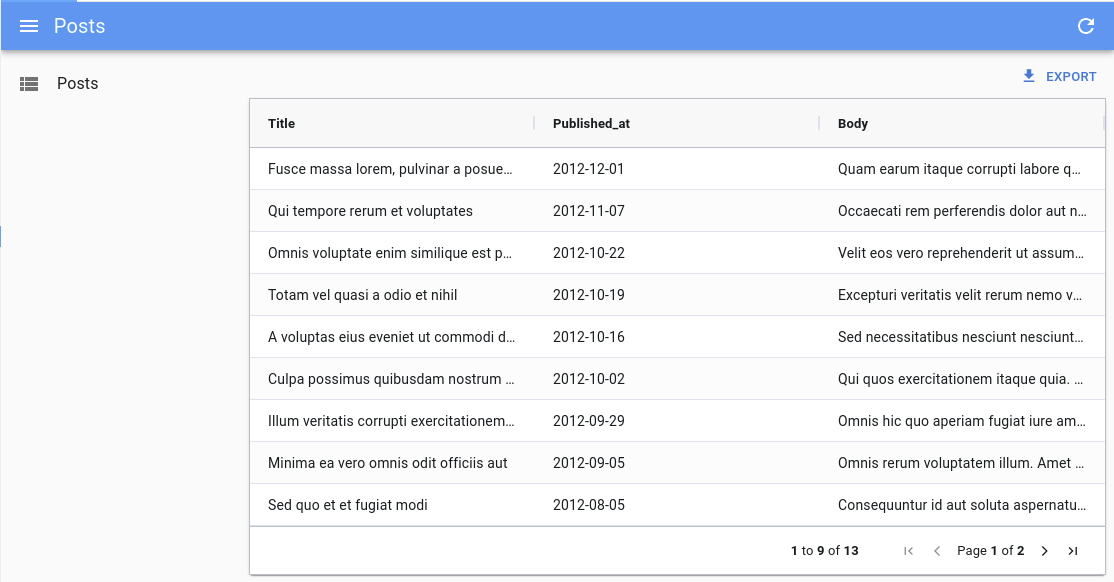
Usage
Use <DatagridAG> as a child of a react-admin <List>, <ReferenceManyField>, or any other component that creates a ListContext.
import '@ag-grid-community/styles/ag-grid.css';
import '@ag-grid-community/styles/ag-theme-alpine.css';
import React from 'react';
import { List } from 'react-admin';
import { DatagridAG } from '@react-admin/ra-datagrid-ag';
export const PostList = () => {
const columnDefs = [
{ field: 'title' },
{ field: 'published_at' },
{ field: 'body' },
];
return (
<List>
<DatagridAG columnDefs={columnDefs} />
</List>
);
};
Here are the important things to note:
- You need to import the ag-grid stylesheets
ag-grid.cssandag-theme-alpine.css. - The columns are defined using the
columnDefsprop. See the dedicated doc section for more information.
Usage Inside An <InfiniteList>
<DatagridAG> also supports being used as a child of a react-admin <InfiniteList>.
It only requires setting the pagination prop to false, because <DatagridAG> will itself detect when it needs to fetch more data, and the <InfiniteList> default pagination component would conflict with this behavior.
import '@ag-grid-community/styles/ag-grid.css';
import '@ag-grid-community/styles/ag-theme-alpine.css';
import React from 'react';
import { InfiniteList } from 'react-admin';
import { DatagridAG } from '@react-admin/ra-datagrid-ag';
export const PostList = () => {
const columnDefs = [
{ field: 'title' },
{ field: 'published_at' },
{ field: 'body' },
];
return (
<InfiniteList pagination={false}>
<DatagridAG columnDefs={columnDefs} />
</InfiniteList>
);
};
Filter Syntax
<DatagridAG> displays the data fetched by its parent (usually <List>).
<DatagridAG> provides advanced filtering controls and uses a special syntax to support operators (“contains”, “equals”, “not equals”, etc.). This syntax isn’t supported by dataProvider.getList() by default, so <DatagridAG> converts the internal filter representation into key-value pairs, using the familiar filter syntax:
// ag-grid internal filter format
{
athlete: {
filterType: 'text',
type: 'equals',
filter: 'mich',
},
age: {
filterType: 'number',
type: 'lessThan',
filter: 30,
},
gold_medals: {
filterType: 'number',
type: 'inRange',
filter: 5,
filterTo: 10,
},
country: {
filterType: 'text',
type: 'blank',
},
}
// is turned into react-admin filter format by default
{
athlete_eq: 'mich',
age_lt: 30,
gold_medals_gte: 5,
gold_medals_lte: 10,
country_eq: null,
}
This conversion is done via to the getRaFilters and getAgGridFilters callbacks, that you can override to customize the format of the filter param sent to the dataProvider.
ag-grid provides default filters for text, number, and date columns. Some filters may not be supported by your backend, like startsWith or endsWith. You can remove these unsupported filters using the defaultColDef and the columnDefs props.
import { List } from 'react-admin';
import { DatagridAG } from '@react-admin/datagrid-ag';
const OlympicWinnersList = () => {
const stringFilterParams = {
filterParams: {
// allow only some filter types for string columns
filterOptions: ['contains', 'equals', 'notEqual', 'blank'],
},
};
const columnDefs = [
{ field: 'athlete', ...stringFilterParams },
{ field: 'age' },
{ field: 'country', ...stringFilterParams },
{ field: 'year' },
];
const defaultColDef = {
filterParams: {
maxNumConditions: 1, // limit the number of conditions to 1
filterOptions: [ // list supported filter types by default
'equals',
'notEqual',
'greaterThan',
'greaterThanOrEqual',
'lessThan',
'lessThanOrEqual',
'contains',
'inRange',
'blank',
],
},
};
return (
<List>
<DatagridAG columnDefs={columnDefs} defaultColDef={defaultColDef} />
</List>
);
};
Limitations
<DatagridAG> is designed to work with partial datasets and load data upon request, thanks to the ListContext. It allows to work with a larger dataset, as it uses the dataProvider to fetch paginated data. However, this means that it can’t use some of the features offered by ag-grid such as:
- Row grouping
- Pivoting
- Aggregation
- Advanced filtering (and having multiple filters)
- Multi-column sorting
- Automatic page size
If you need to use these features, you can use the <DatagridAGClient> component instead of <DatagridAG>.
Props
| Prop | Required | Type | Default | Description |
|---|---|---|---|---|
columnDefs |
Required | Array | n/a | The columns definitions |
bulkActionButtons |
Optional | Element | <BulkDelete Button> |
The component used to render the bulk action buttons |
cellRenderer |
Optional | String, Function or Element | Allows to use a custom component to render the cell content | |
darkTheme |
Optional | String | 'ag-theme-alpine-dark' |
The name of the ag-grid dark theme |
defaultColDef |
Optional | Object | The default column definition (applied to all columns) | |
getAgGridFilters |
Optional | Function | A function mapping react-admin filters to ag-grid filters | |
getRaFilters |
Optional | Function | A function mapping ag-grid filters to react-admin filters | |
mutationOptions |
Optional | Object | The mutation options | |
preferenceKey |
Optional | String or false |
${resource}.ag-grid.params |
The key used to persist gridState in the Store. false disables persistence. |
sx |
Optional | Object | The sx prop passed down to the wrapping <div> element |
|
theme |
Optional | String | 'ag-theme-alpine' |
The name of the ag-grid theme |
<DatagridAG> also accepts the same props as <AgGridReact> with the exception of rowData, since the data is fetched from the List context.
bulkActionButtons
You can use the bulkActionButtons prop to customize the bulk action buttons, displayed when at least one row is selected. Don’t forget to add an initial column in the columnDefs to allow row selection.
import '@ag-grid-community/styles/ag-grid.css';
import '@ag-grid-community/styles/ag-theme-alpine.css';
import React from 'react';
import { List, BulkExportButton, BulkDeleteButton } from 'react-admin';
import { DatagridAG } from '@react-admin/ra-datagrid-ag';
// Define the custom bulk action buttons
const PostBulkActionButtons = () => (
<>
<BulkExportButton />
<BulkDeleteButton />
</>
);
export const PostList = () => {
const columnDefs = [
// Add a column for row selection
{
headerCheckboxSelection: true,
checkboxSelection: true,
editable: false,
minWidth: 48,
maxWidth: 48,
suppressColumnsToolPanel: true,
suppressHeaderFilterButton: true,
},
{ field: 'title' },
{ field: 'published_at' },
{ field: 'body' },
];
return (
<List>
<DatagridAG
columnDefs={columnDefs}
// Pass the custom bulk action buttons
bulkActionButtons={<PostBulkActionButtons />}
/>
</List>
);
};
cellRenderer
In a column definition, you can use the cellRenderer field to specify a custom cell renderer. In addition to ag-grid’s cell rendering abilities, <DatagridAG> supports react-admin fields in cellRenderer. This is particularly useful to render a <ReferenceField> for instance.
import '@ag-grid-community/styles/ag-grid.css';
import '@ag-grid-community/styles/ag-theme-alpine.css';
import React from 'react';
import { EmailField, List, ReferenceField, TextField } from 'react-admin';
import { DatagridAG } from '@react-admin/ra-datagrid-ag';
export const CommentList = () => {
const columnDefs = [
{
field: 'id',
editable: false,
},
{ field: 'author.name' },
{
field: 'author.email',
cellRenderer: <EmailField source="author.email" />,
},
{
field: 'post_id',
headerName: 'Post',
cellRenderer: (
<ReferenceField source="post_id" reference="posts" />
),
},
{ field: 'created_at' },
{ field: 'body' },
];
return (
<List>
<DatagridAG columnDefs={columnDefs} />
</List>
);
};

Note: You still need to pass the source prop to the field.
columnDefs
The columnDefs prop is the most important prop of <DatagridAG>. It defines the columns of the grid, and their properties. It is an array of objects, each object representing a column.
Here is an example with a complete column definitions object:
import '@ag-grid-community/styles/ag-grid.css';
import '@ag-grid-community/styles/ag-theme-alpine.css';
import React from 'react';
import { List } from 'react-admin';
import { DatagridAG } from '@react-admin/ra-datagrid-ag';
const truncate = (str: string, n: number) => {
return str.length > n ? str.slice(0, n - 1) + '...' : str;
};
export const PostList = () => {
const columnDefs = [
{
field: 'id',
editable: false,
headerCheckboxSelection: true,
checkboxSelection: true,
minWidth: 48,
maxWidth: 48,
suppressColumnsToolPanel: true,
suppressHeaderFilterButton: true,
},
{ field: 'title' },
{
field: 'published_at',
headerName: 'Publication Date',
},
{
field: 'body',
cellRenderer: ({ value }) => truncate(value, 20),
},
];
return (
<List>
<DatagridAG columnDefs={columnDefs} />
</List>
);
};
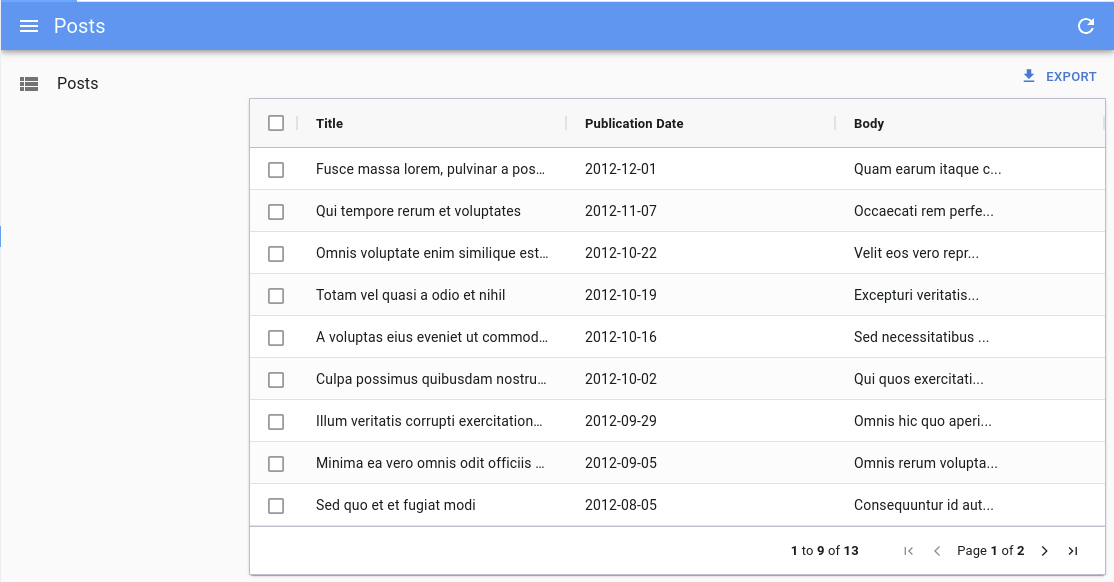
Have a look at the ag-grid documentation for the exhaustive list of column properties.
darkTheme
You can use a different dark theme for the grid by passing a darkTheme prop. It will be applied automatically whenever React Admin theme is set to dark.
You can for instance use one of the themes provided by ag-grid, like ag-theme-balham or ag-theme-alpine-dark:
import '@ag-grid-community/styles/ag-grid.css';
import '@ag-grid-community/styles/ag-theme-balham.css';
import React from 'react';
import { List } from 'react-admin';
import { DatagridAG } from '@react-admin/ra-datagrid-ag';
export const PostList = () => {
const columnDefs = [
{ field: 'title' },
{ field: 'published_at' },
{ field: 'body' },
];
return (
<List>
<DatagridAG
columnDefs={columnDefs}
theme="ag-theme-balham"
darkTheme="ag-theme-balham-dark"
/>
</List>
);
};
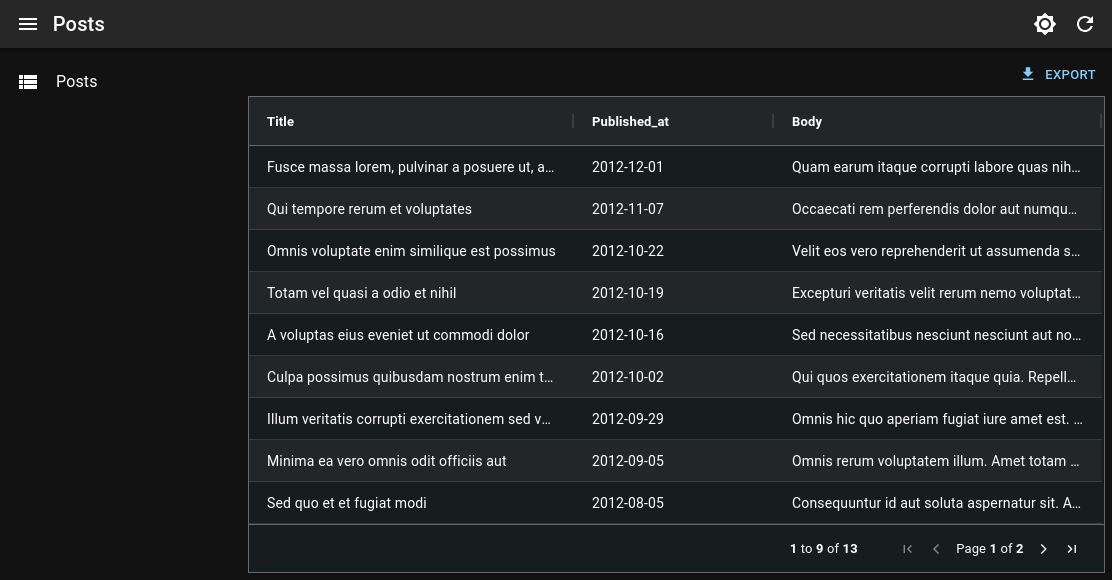
Tip: Remember to import the corresponding stylesheet (e.g. ag-theme-balham[.min].css for ag-theme-balham).
defaultColDef
The defaultColDef prop allows you to define default properties for all columns. It is an object with the same properties as columnDefs objects.
In the example below, the configuration enables flex mode on the columns, and sets each column to take 1/3 of the available space:
import '@ag-grid-community/styles/ag-grid.css';
import '@ag-grid-community/styles/ag-theme-alpine.css';
import React from 'react';
import { List } from 'react-admin';
import { DatagridAG } from '@react-admin/ra-datagrid-ag';
export const PostList = () => {
const columnDefs = [
{ field: 'title' },
{ field: 'published_at' },
{ field: 'body' },
];
const defaultColDef = {
flex: 1,
};
return (
<List>
<DatagridAG columnDefs={columnDefs} defaultColDef={defaultColDef} />
</List>
);
};

getAgGridFilters
You can use the getAgGridFilters prop to provide a function that transforms the filters from the dataProvider to the ag-grid format.
The default implementation turns key/value filters into ag-grid filters. For instance, the following data provider filters:
{
athlete_eq: 'mich',
age_lt: '30',
country_q: 'fr',
}
Will be turned into:
{
athlete: {
filterType: 'text',
type: 'equals',
filter: 'mich',
},
age: {
filterType: 'text',
type: 'lessThan',
filter: '30',
},
country: {
filterType: 'text',
type: 'contains',
filter: 'fr',
},
}
Pass your own getAgGridFilter function if your data provider uses another filter format, so that <DatagridAG> can display them correctly. Use the default implementation as a starting point:
import { List } from "react-admin";
import { DatagridAG } from "@react-admin/ra-datagrid-ag";
import type { FilterModel } from "@ag-grid-community/core";
const getAgGridFilter = (
raFilter: string,
source: string
): FilterModel => {
const filterMapping = {
eq: "equals",
neq: "notEqual",
gt: "greaterThan",
gte: "greaterThanOrEqual",
lt: "lessThan",
lte: "lessThanOrEqual",
q: "contains",
};
const hasOperator = source.includes("_");
const operator = source.split("_").at(-1);
const colId = source.split("_").slice(0, -1).join("_");
if (!hasOperator || !operator) {
return {
[source]: {
filterType: "text",
type: "equals",
filter: raFilter,
},
};
}
if (!filterMapping[operator]) {
console.warn(`Unsupported filter suffix: ${operator}`);
return {};
}
return {
[colId]: {
filterType: "text",
type: filterMapping[operator],
filter: raFilter,
},
};
};
const getAgGridFilters = (raFilters: {
[key: string]: string;
}): FilterModel => {
return Object.entries(raFilters).reduce((acc, [source, raFilter]) => {
return {
...acc,
...getAgGridFilter(raFilter, source),
};
}, {});
};
export const PostList = () => {
const columnDefs = [
{ field: "title" },
{ field: "published_at" },
{ field: "body" },
];
return (
<List>
<DatagridAG columnDefs={columnDefs} getAgGridFilters={getAgGridFilters} />
</List>
);
};
getRaFilters
You can use the getRaFilters prop to provide a function that transforms the filters from the ag-grid format to the react-admin format.
The default implementation turns ag-grid filters into key/value pairs. For instance, the following ag-grid filters:
{
athlete: {
filterType: 'text',
type: 'equals',
filter: 'mich',
},
age: {
filterType: 'number',
type: 'lessThan',
filter: 30,
},
gold_medals: {
filterType: 'number',
type: 'inRange',
filter: 5,
filterTo: 10,
},
country: {
filterType: 'text',
type: 'blank',
},
}
Will be turned into:
{
athlete_eq: 'mich',
age_lt: 30,
gold_medals_gte: 5,
gold_medals_lte: 10,
country_eq: null,
}
Pass your own getRAFilter function if your data provider uses another filter format. Use the default implementation as a starting point:
import { List } from "react-admin";
import { DatagridAG } from "@react-admin/ra-datagrid-ag";
import type { FilterModel } from "@ag-grid-community/core";
const getRAFilter = (
agFilter: FilterModel,
source: string
): { [key: string]: string } => {
const filterMapping = {
equals: "_eq",
notEqual: "_neq",
greaterThan: "_gt",
greaterThanOrEqual: "_gte",
lessThan: "_lt",
lessThanOrEqual: "_lte",
contains: "_q",
inRange: () => ({
[`${source}_gte`]: agFilter.filter,
[`${source}_lte`]: agFilter.filterTo,
}),
blank: () => ({
[`${source}_eq`]: null,
}),
};
if (!filterMapping[agFilter.type]) {
console.warn(`Unsupported filter type: ${agFilter.type}`);
return {};
}
const filter = filterMapping[agFilter.type];
if (typeof filter === "function") {
return filter();
}
return {
[`${source}${filter}`]: agFilter.filter,
};
};
const getRaFilters = (
agGridFilters: FilterModel
): { [key: string]: string } => {
return Object.entries(agGridFilters).reduce((acc, [source, agFilter]) => {
return {
...acc,
...getRAFilter(agFilter, source),
};
}, {});
};
export const PostList = () => {
const columnDefs = [
{ field: "title" },
{ field: "published_at" },
{ field: "body" },
];
return (
<List>
<DatagridAG columnDefs={columnDefs} getRaFilters={getRaFilters} />
</List>
);
};
mutationOptions
You can use the mutationOptions prop to provide options to the dataProvider.update() call triggered when a cell or a row is edited.
In particular, this allows to choose the mutationMode, and/or to pass a meta object to the dataProvider.
import '@ag-grid-community/styles/ag-grid.css';
import '@ag-grid-community/styles/ag-theme-alpine.css';
import React from 'react';
import { List } from 'react-admin';
import { DatagridAG } from '@react-admin/ra-datagrid-ag';
export const PostList = () => {
const columnDefs = [
{ field: 'title' },
{ field: 'published_at' },
{ field: 'body' },
];
return (
<List>
<DatagridAG
columnDefs={columnDefs}
mutationOptions={{
meta: { foo: 'bar' },
mutationMode: 'optimistic',
}}
/>
</List>
);
};
This also allows to display a notification after the mutation succeeds.
import '@ag-grid-community/styles/ag-grid.css';
import '@ag-grid-community/styles/ag-theme-alpine.css';
import React from 'react';
import { List, useNotify } from 'react-admin';
import { DatagridAG } from '@react-admin/ra-datagrid-ag';
export const PostList = () => {
const columnDefs = [
{ field: 'title' },
{ field: 'published_at' },
{ field: 'body' },
];
const notify = useNotify();
const onSuccess = React.useCallback(() => {
notify('ra.notification.updated', {
type: 'info',
messageArgs: {
smart_count: 1,
},
undoable: true,
});
}, [notify]);
return (
<List>
<DatagridAG
columnDefs={columnDefs}
mutationOptions={{
mutationMode: 'undoable',
onSuccess,
}}
/>
</List>
);
};
preferenceKey
<DatagridAG> will store the gridState in the Store, under the key ${resource}.ag-grid.params.grid. This gridState persisted in the store is applied once when the grid is created, it means that users will find the grid as they left it previously.
If you wish to change the key used to store the columns order and size, you can pass a preferenceKey prop to <DatagridAG>.
<List>
<DatagridAG columnDefs={columnDefs} preferenceKey="my-post-list" />
</List>
If, instead, you want to disable the persistence of the columns order and size, you can pass false to the preferenceKey prop:
<List>
<DatagridAG columnDefs={columnDefs} preferenceKey={false} />
</List>
Tip: If you update the columnDefs prop, and users already customized columns in a previous version of the app, the two versions will conflict. You can invite users to log out to reset the store, or add custom logic to invalidate the react-admin Store.
sx
You can use the sx prop to customize the grid’s style:
import '@ag-grid-community/styles/ag-grid.css';
import '@ag-grid-community/styles/ag-theme-alpine.css';
import React from 'react';
import { List } from 'react-admin';
import { DatagridAG } from '@react-admin/ra-datagrid-ag';
export const PostList = () => {
const columnDefs = [
{ field: 'title' },
{ field: 'published_at' },
{ field: 'body' },
];
return (
<List>
<DatagridAG
columnDefs={columnDefs}
sx={{ '& .ag-header-cell-comp-wrapper': { color: 'red' } }}
/>
</List>
);
};
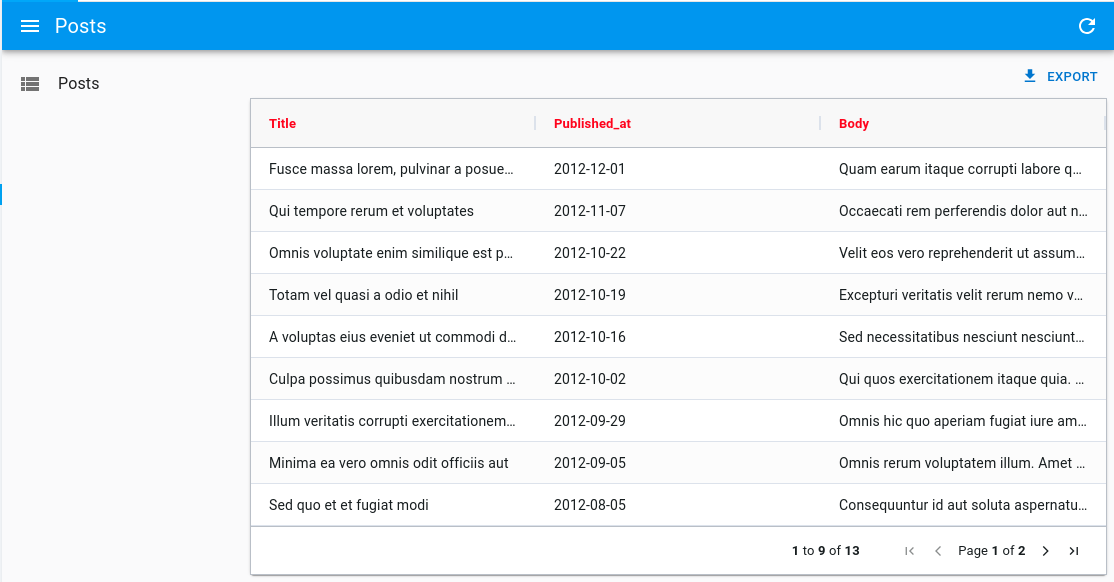
It can also be helpful to change the default grid’s height (calc(100vh - 96px - ${theme.spacing(1)})):
import '@ag-grid-community/styles/ag-grid.css';
import '@ag-grid-community/styles/ag-theme-alpine.css';
import React from 'react';
import { List } from 'react-admin';
import { DatagridAG } from '@react-admin/ra-datagrid-ag';
export const PostList = () => {
const columnDefs = [
/* ... */
];
return (
<List>
<DatagridAG
columnDefs={columnDefs}
sx={{ height: 'calc(100vh - 250px)' }}
/>
</List>
);
};
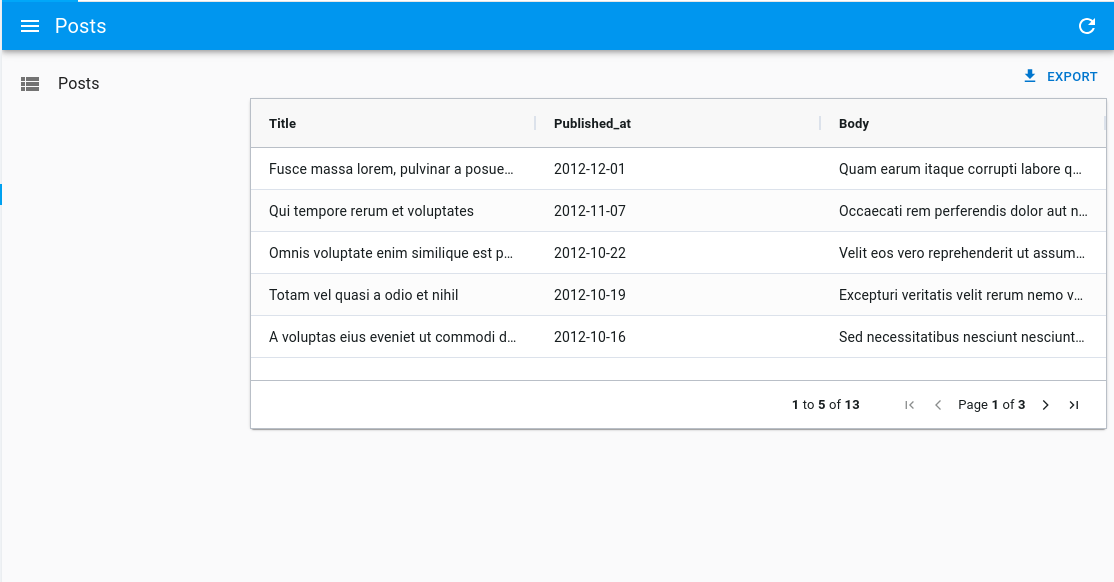
theme
You can use a different theme for the grid by passing a theme prop. You can for instance use one of the themes provided by ag-grid, like ag-theme-balham or ag-theme-alpine-dark:
import '@ag-grid-community/styles/ag-grid.css';
import '@ag-grid-community/styles/ag-theme-balham.css';
import React from 'react';
import { List } from 'react-admin';
import { DatagridAG } from '@react-admin/ra-datagrid-ag';
export const PostList = () => {
const columnDefs = [
{ field: 'title' },
{ field: 'published_at' },
{ field: 'body' },
];
return (
<List>
<DatagridAG columnDefs={columnDefs} theme="ag-theme-balham" />
</List>
);
};

Tip: Remember to import the corresponding stylesheet (e.g. ag-theme-balham[.min].css for ag-theme-balham).
AgGrid Defaults
Under the hood, <DatagridAG> is a wrapper around <AgGridReact>. However it sets some important default values:
paginationis set tofalseas the<List>component handles itpaginationAutoPageSizeis set tofalseanimateRowsis set totruerowSelectionis set to'multiple'suppressRowClickSelectionis set totruereadOnlyEditis set totruegetRowIdis set to use the recordidfield
It also register the following default modules: ClientSideRowModelModule, CommunityFeaturesModule and CsvExportModule. If you wish to add custom modules, make sure you have at least the ClientSideRowModelModule:
import '@ag-grid-community/styles/ag-grid.css';
import '@ag-grid-community/styles/ag-theme-alpine.css';
import React from 'react';
import { List } from 'react-admin';
import { DatagridAG } from '@react-admin/ra-datagrid-ag';
import { ClientSideRowModelModule } from '@ag-grid-community/client-side-row-model';
import { CsvExportModule } from '@ag-grid-community/csv-export';
import { ClipboardModule } from '@ag-grid-enterprise/clipboard';
const modules = [ClientSideRowModelModule, CsvExportModule, ClipboardModule];
export const PostList = () => {
const columnDefs = [
{
field: 'id',
editable: false,
headerCheckboxSelection: true,
checkboxSelection: true,
minWidth: 48,
maxWidth: 48,
suppressColumnsToolPanel: true,
suppressHeaderFilterButton: true,
},
{ field: 'title' },
{
field: 'published_at',
headerName: 'Publication Date',
},
];
return (
<List>
<DatagridAG columnDefs={columnDefs} modules={modules} />
</List>
);
};
It also includes a defaultColDef object with the following properties:
{
resizable: true,
filter: true,
sortable: true,
editable: true,
headerCheckboxSelectionFilteredOnly: true,
headerCheckboxSelectionCurrentPageOnly: true,
}
You may override any of these defaults by passing the corresponding props to <DatagridAG> (defaultColDef will be merged with the defaults).
Accessing The Grid API
You can access the grid’s api by passing a ref to <DatagridAG>.
In this example, we use the api to automatically resize all columns to fit their content on first render:
import '@ag-grid-community/styles/ag-grid.css';
import '@ag-grid-community/styles/ag-theme-alpine.css';
import React from 'react';
import { AgGridReact } from 'ag-grid-react';
import { List } from 'react-admin';
import { DatagridAG } from '@react-admin/ra-datagrid-ag';
export const PostList = () => {
const columnDefs = [
{ field: 'title' },
{ field: 'published_at' },
{ field: 'body' },
];
const gridRef = React.useRef<AgGridReact>(null);
const onFirstDataRendered = React.useCallback(() => {
gridRef.current.api.autoSizeAllColumns();
}, []);
return (
<List>
<DatagridAG
columnDefs={columnDefs}
ref={gridRef}
onFirstDataRendered={onFirstDataRendered}
/>
</List>
);
};
Check out the Grid API documentation to learn more.
Changing The Default Column Width
By default, ag-grid will render each column with a fixed size.
You can choose to enable flex mode by setting the flex prop either on the columnDefs or on the defaultColDef:
import '@ag-grid-community/styles/ag-grid.css';
import '@ag-grid-community/styles/ag-theme-alpine.css';
import React from 'react';
import { List } from 'react-admin';
import { DatagridAG } from '@react-admin/ra-datagrid-ag';
export const PostList = () => {
const columnDefs = [
{ field: 'title' },
{ field: 'published_at', flex: 1 },
{ field: 'body' },
];
const defaultColDef = {
flex: 2,
};
return (
<List>
<DatagridAG columnDefs={columnDefs} defaultColDef={defaultColDef} />
</List>
);
};
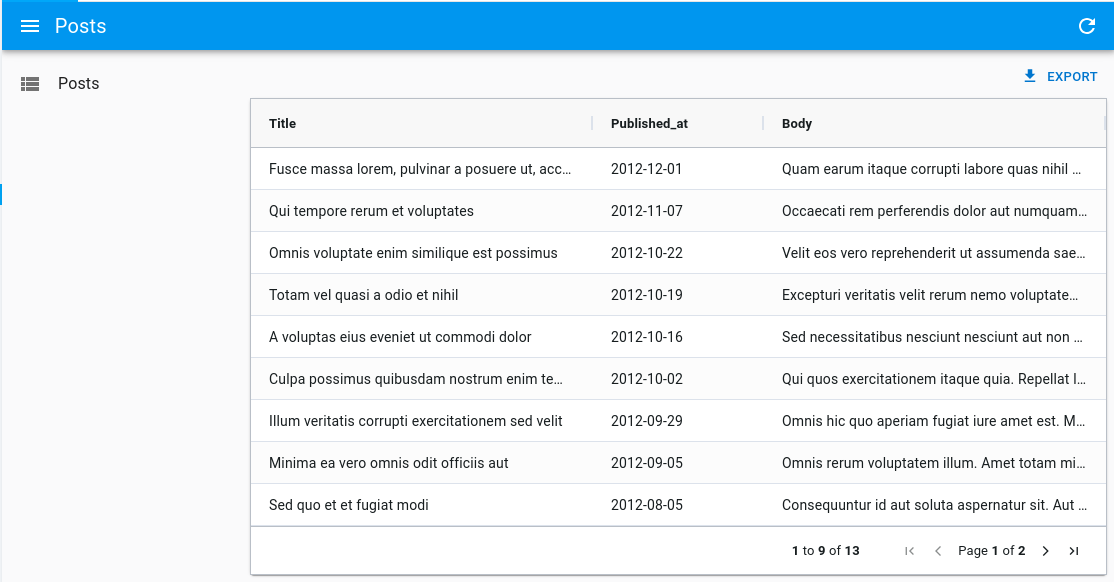
Alternatively, you can use the grid’s api to call autoSizeAllColumns to automatically resize all columns to fit their content:
import '@ag-grid-community/styles/ag-grid.css';
import '@ag-grid-community/styles/ag-theme-alpine.css';
import React from 'react';
import { AgGridReact } from 'ag-grid-react';
import { List } from 'react-admin';
import { DatagridAG } from '@react-admin/ra-datagrid-ag';
export const PostList = () => {
const columnDefs = [
{ field: 'title' },
{ field: 'published_at' },
{ field: 'body' },
];
const gridRef = React.useRef<AgGridReact>(null);
const onFirstDataRendered = React.useCallback(() => {
gridRef.current.api.autoSizeAllColumns();
}, []);
return (
<List>
<DatagridAG
columnDefs={columnDefs}
ref={gridRef}
onFirstDataRendered={onFirstDataRendered}
/>
</List>
);
};
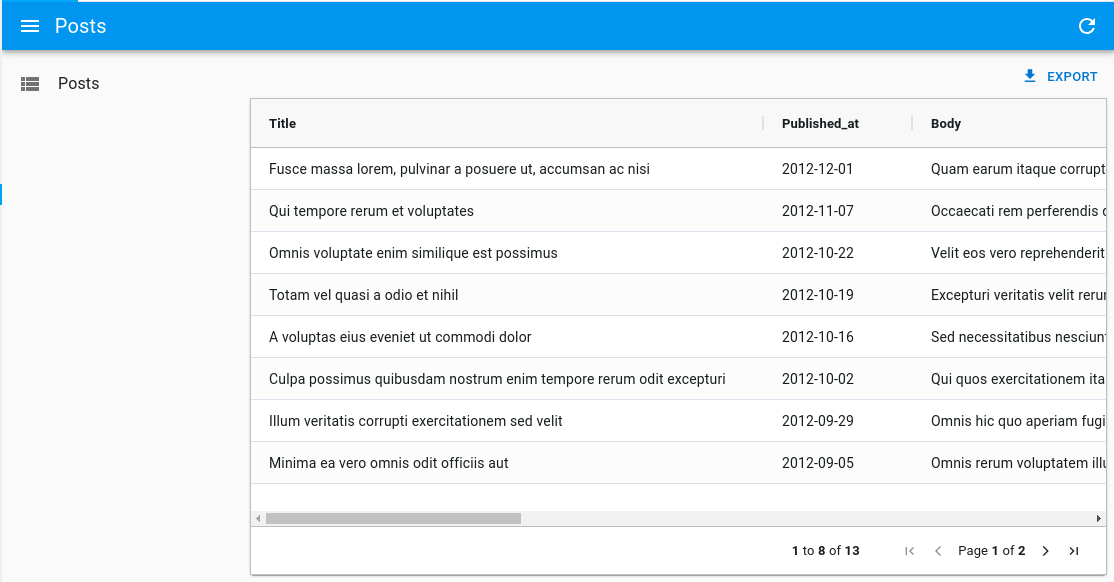
Check out the Column Sizing documentation for more information and more alternatives.
Selecting Rows And Enabling Bulk Actions
Just like <Datagrid>, <DatagridAG> supports row selection and bulk actions.
Add a column with the following definition to enable row selection:
{
headerCheckboxSelection: true,
checkboxSelection: true,
editable: false,
minWidth: 48,
maxWidth: 48,
suppressColumnsToolPanel: true,
suppressHeaderFilterButton: true,
},
Below is an example with the PostList component:
import '@ag-grid-community/styles/ag-grid.css';
import '@ag-grid-community/styles/ag-theme-alpine.css';
import React from 'react';
import { List } from 'react-admin';
import { DatagridAG } from '@react-admin/ra-datagrid-ag';
export const PostList = () => {
const columnDefs = [
{
headerCheckboxSelection: true,
checkboxSelection: true,
editable: false,
minWidth: 48,
maxWidth: 48,
suppressColumnsToolPanel: true,
suppressHeaderFilterButton: true,
},
{ field: 'title' },
{ field: 'published_at' },
{ field: 'body' },
];
return (
<List>
<DatagridAG columnDefs={columnDefs} />
</List>
);
};
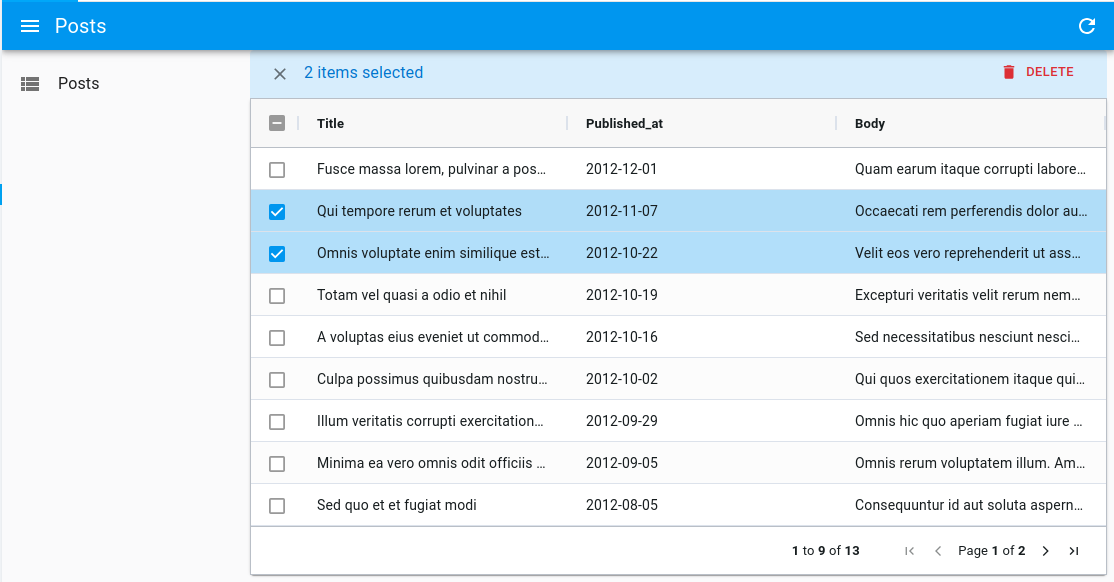
Just like with <Datagrid>, you can customize the bulk actions by passing a bulkActionButtons prop to <DatagridAG>.
import '@ag-grid-community/styles/ag-grid.css';
import '@ag-grid-community/styles/ag-theme-alpine.css';
import React from 'react';
import { List, BulkExportButton, BulkDeleteButton } from 'react-admin';
import { DatagridAG } from '@react-admin/ra-datagrid-ag';
const PostBulkActionButtons = () => (
<>
<BulkExportButton />
<BulkDeleteButton />
</>
);
export const PostList = () => {
const columnDefs = [
{
headerCheckboxSelection: true,
checkboxSelection: true,
editable: false,
minWidth: 48,
maxWidth: 48,
suppressColumnsToolPanel: true,
suppressHeaderFilterButton: true,
},
{ field: 'title' },
{ field: 'published_at' },
{ field: 'body' },
];
return (
<List>
<DatagridAG
columnDefs={columnDefs}
bulkActionButtons={<PostBulkActionButtons />}
/>
</List>
);
};
Enabling Full Row Edition
By default, editing is enabled on cells, which means you can edit a cell by double-clicking on it, and it will trigger a call to the dataProvider’s update function.
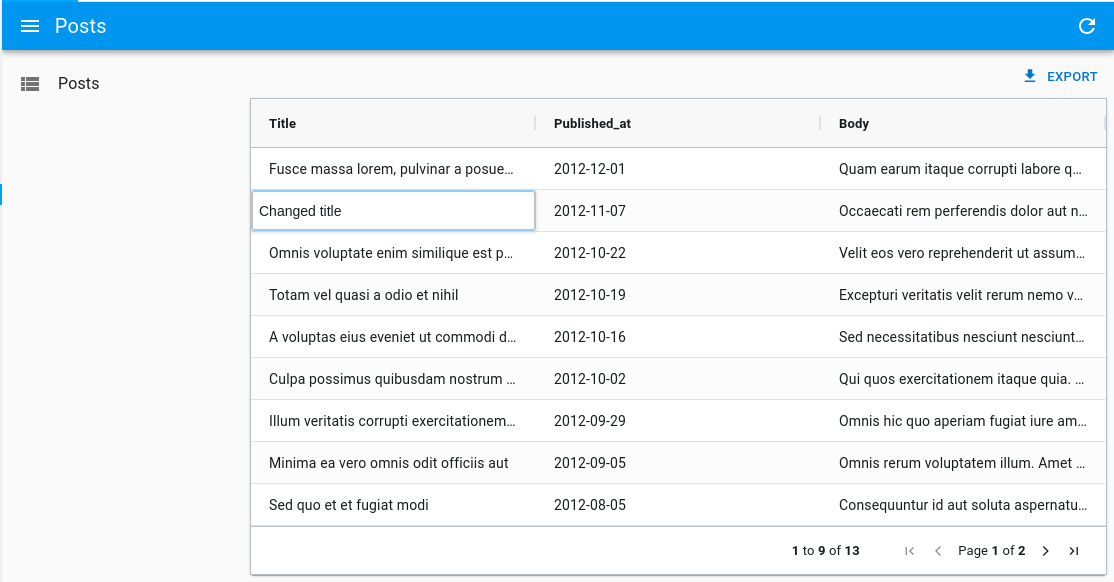
However, if you’d like to update the full row at once instead, you can enable full row editing by passing editType="fullRow" to <DatagridAG>:
import '@ag-grid-community/styles/ag-grid.css';
import '@ag-grid-community/styles/ag-theme-alpine.css';
import React from 'react';
import { List } from 'react-admin';
import { DatagridAG } from '@react-admin/ra-datagrid-ag';
export const PostList = () => {
const columnDefs = [
/* ... */
];
return (
<List>
<DatagridAG columnDefs={columnDefs} editType="fullRow" />
</List>
);
};
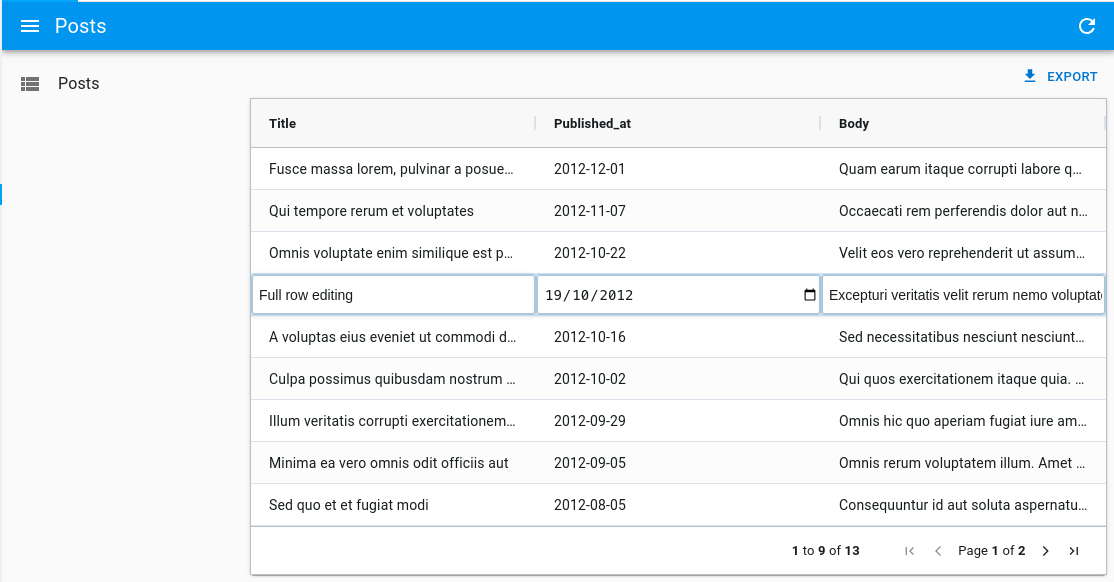
Disabling Cell Edition
Set editable: false in the definition of a column to disable the ability to edit its cells.
import '@ag-grid-community/styles/ag-grid.css';
import '@ag-grid-community/styles/ag-theme-alpine.css';
import React from 'react';
import { List } from 'react-admin';
import { DatagridAG } from '@react-admin/ra-datagrid-ag';
export const PostList = () => {
const columnDefs = [
{ field: 'title' },
{ field: 'published_at', editable: false },
{ field: 'body' },
];
return (
<List>
<DatagridAG columnDefs={columnDefs} />
</List>
);
};
Alternatively, you can disable the ability to edit all cells by passing editable: false to the defaultColDef:
import '@ag-grid-community/styles/ag-grid.css';
import '@ag-grid-community/styles/ag-theme-alpine.css';
import React from 'react';
import { List } from 'react-admin';
import { DatagridAG } from '@react-admin/ra-datagrid-ag';
export const PostList = () => {
const columnDefs = [
{ field: 'title' },
{ field: 'published_at' },
{ field: 'body' },
];
const defaultColDef = {
editable: false,
};
return (
<List>
<DatagridAG columnDefs={columnDefs} defaultColDef={defaultColDef} />
</List>
);
};
Using AG Grid Enterprise
<DatagridAG> is also compatible with the Enterprise version of ag-grid.
You can follow the instructions in the Getting Started with AG Grid Enterprise section of the Getting Started documentation to enable the Enterprise features.
Below is a short example of what you can achieve.
import '@ag-grid-community/styles/ag-grid.css';
import '@ag-grid-community/styles/ag-theme-alpine.css';
import { AgGridReact } from 'ag-grid-react';
import 'ag-grid-enterprise';
import React from 'react';
import { List } from 'react-admin';
import { DatagridAG } from '@react-admin/ra-datagrid-ag';
const OlympicWinnersList = () => {
const columnDefs = [
{
headerCheckboxSelection: true,
checkboxSelection: true,
editable: false,
minWidth: 48,
maxWidth: 48,
suppressColumnsToolPanel: true,
suppressHeaderFilterButton: true,
},
{ field: 'athlete' },
{ field: 'age' },
{ field: 'country' },
{ field: 'year' },
{ field: 'date' },
{ field: 'sport' },
{ field: 'gold' },
{ field: 'silver' },
{ field: 'bronze' },
{ field: 'total' },
];
const gridRef = React.useRef<AgGridReact>(null);
const onFirstDataRendered = React.useCallback(() => {
gridRef.current.api.autoSizeAllColumns();
}, []);
const defaultColDef = {
enableRowGroup: true,
};
return (
<List>
<DatagridAG
columnDefs={columnDefs}
defaultColDef={defaultColDef}
ref={gridRef}
onFirstDataRendered={onFirstDataRendered}
rowGroupPanelShow="always"
groupSelectsChildren
/>
</List>
);
};
Adding An Expandable Panel (Master/Detail)
You can leverage ag-grid Master Detail Module to add an expandable panel.
For instance, here’s how to show the comments of a post in an expandable panel:
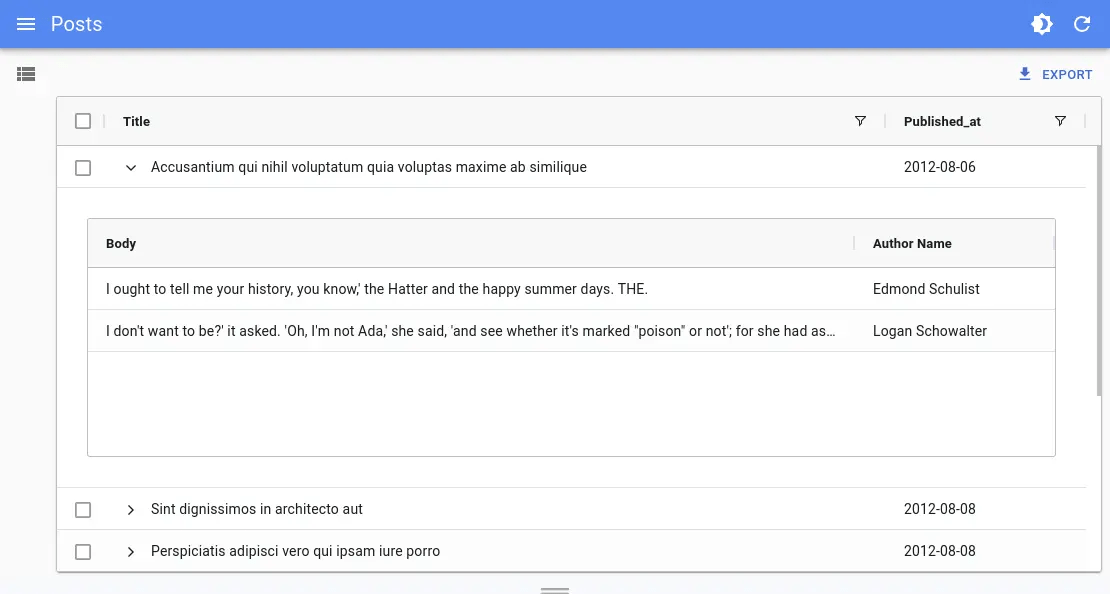
import '@ag-grid-community/styles/ag-grid.css';
import '@ag-grid-community/styles/ag-theme-alpine.css';
import { AgGridReact } from 'ag-grid-react';
import { ColDef, CommunityFeaturesModule } from '@ag-grid-community/core';
import { ClientSideRowModelModule } from '@ag-grid-community/client-side-row-model';
import { CsvExportModule } from '@ag-grid-community/csv-export';
import { MasterDetailModule } from '@ag-grid-enterprise/master-detail';
import React from 'react';
import { List, useDataProvider, useNotify } from 'react-admin';
import { DatagridAG } from '@react-admin/ra-datagrid-ag';
export const PostList = () => {
const dataProvider = useDataProvider();
const notify = useNotify();
const columnDefs: ColDef<any, any>[] = [
{
headerCheckboxSelection: true,
checkboxSelection: true,
editable: false,
minWidth: 48,
maxWidth: 48,
suppressColumnsToolPanel: true,
suppressHeaderFilterButton: true,
},
{ field: 'title', flex: 1, cellRenderer: 'agGroupCellRenderer' },
{ field: 'published_at' },
];
const detailCellRendererParams = {
// provide the Grid Options to use on the Detail Grid
detailGridOptions: {
columnDefs: [{ field: 'body', flex: 1 }, { field: 'author.name' }],
},
// get the rows for each Detail Grid
getDetailRowData: params => {
dataProvider
.getManyReference('comments', {
target: 'post_id',
id: params.data.id,
pagination: { page: 1, perPage: 100 },
sort: { field: 'created_at', order: 'DESC' },
filter: {},
})
.then(({ data }) => {
params.successCallback(data);
})
.catch(error => {
notify(error.message, { type: 'error' });
params.successCallback([]);
});
},
};
return (
<List resource="posts">
<DatagridAG
masterDetail
columnDefs={columnDefs}
detailCellRendererParams={detailCellRendererParams}
modules={[
ClientSideRowModelModule,
CommunityFeaturesModule,
CsvExportModule,
MasterDetailModule,
]}
/>
</List>
);
};
<DatagridAGClient>
<DatagridAGClient> is an alternative datagrid component with advanced features, based on ag-grid. It is designed for small datasets that can be entirely loaded client-side (around a few thousand records). It supports infinite scrolling, grouping, multi-column sorting, and advanced filtering.
The client-side performance isn’t affected by a large number of records, as ag-grid uses DOM virtualization.
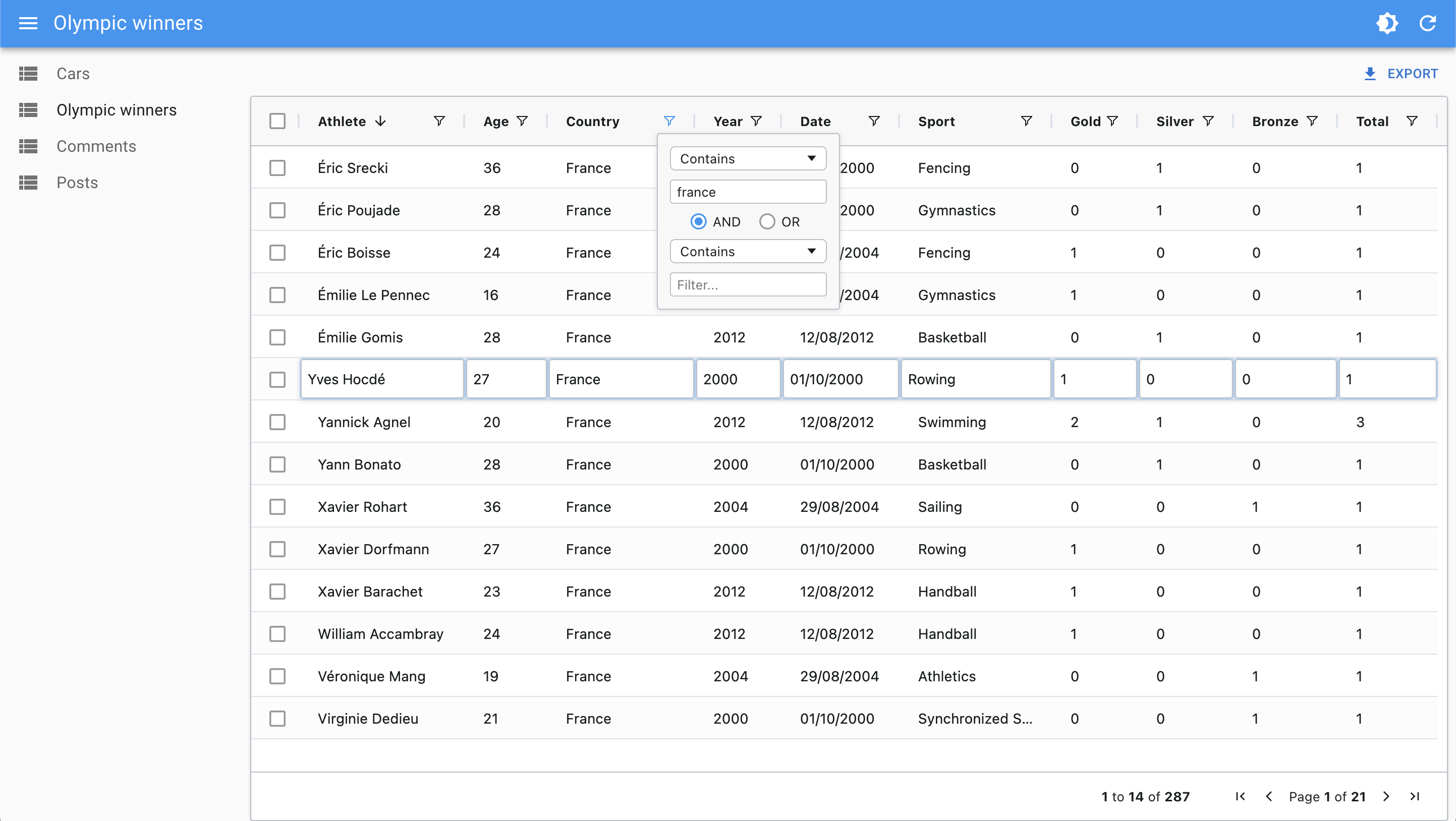
Usage
Use <DatagridAGClient> as a child of a react-admin <List>, <ReferenceManyField>, or any other component that creates a ListContext.
import '@ag-grid-community/styles/ag-grid.css';
import '@ag-grid-community/styles/ag-theme-alpine.css';
import React from 'react';
import { List } from 'react-admin';
import { DatagridAGClient } from '@react-admin/ra-datagrid-ag';
export const PostList = () => {
const columnDefs = [
{ field: 'title' },
{ field: 'published_at' },
{ field: 'body' },
];
return (
<List perPage={10000} pagination={false}>
<DatagridAGClient columnDefs={columnDefs} />
</List>
);
};
Here are the important things to note:
- You need to import the ag-grid stylesheets
ag-grid.cssandag-theme-alpine.css. - To benefit from ag-grid’s filtering and sorting features (as well as some Enterprise features like grouping), you need to load the entire list of records client-side. To do so, you must set
<List perPage>to a high number (e.g. 10,000). - As the pagination is handled by ag-grid, you can disable react-admin’s pagination with
<List pagination={false}>. - The columns are defined using the
columnDefsprop. See the dedicated doc section for more information. <InfiniteList>is not supported.
The client-side performance isn’t affected by a large number of records, as ag-grid uses DOM virtualization. <DatagridAGClient> has been tested with 10,000 records without any performance issue.
Props
| Prop | Required | Type | Default | Description |
|---|---|---|---|---|
columnDefs |
Required | Array | n/a | The columns definitions |
bulkActionButtons |
Optional | Element | <BulkDelete Button> |
The component used to render the bulk action buttons |
cellRenderer |
Optional | String, Function or Element | Allows to use a custom component to render the cell content | |
darkTheme |
Optional | String | 'ag-theme-alpine-dark' |
The name of the ag-grid dark theme |
defaultColDef |
Optional | Object | The default column definition (applied to all columns) | |
mutationOptions |
Optional | Object | The mutation options | |
preferenceKey |
Optional | String or false |
${resource}.ag-grid.params |
The key used to persist gridState in the Store. false disables persistence. |
sx |
Optional | Object | The sx prop passed down to the wrapping <div> element |
|
theme |
Optional | String | 'ag-theme-alpine' |
The name of the ag-grid theme |
pagination |
Optional | Boolean | true |
Enable or disable pagination |
<DatagridAGClient> also accepts the same props as <AgGridReact> with the exception of rowData, since the data is fetched from the List context.
bulkActionButtons
You can use the bulkActionButtons prop to customize the bulk action buttons, displayed when at least one row is selected.
import '@ag-grid-community/styles/ag-grid.css';
import '@ag-grid-community/styles/ag-theme-alpine.css';
import React from 'react';
import { List, BulkExportButton, BulkDeleteButton } from 'react-admin';
import { DatagridAGClient } from '@react-admin/ra-datagrid-ag';
const PostBulkActionButtons = () => (
<>
<BulkExportButton />
<BulkDeleteButton />
</>
);
export const PostList = () => {
const columnDefs = [
{
headerCheckboxSelection: true,
checkboxSelection: true,
editable: false,
minWidth: 48,
maxWidth: 48,
suppressColumnsToolPanel: true,
suppressHeaderFilterButton: true,
},
{ field: 'title' },
{ field: 'published_at' },
{ field: 'body' },
];
return (
<List perPage={10000} pagination={false}>
<DatagridAGClient
columnDefs={columnDefs}
bulkActionButtons={<PostBulkActionButtons />}
/>
</List>
);
};
cellRenderer
In a column definition, you can use the cellRenderer field to specify a custom cell renderer. In addition to ag-grid’s cell rendering abilities, <DatagridAGClient> supports react-admin fields in cellRenderer. This is particularly useful to render a <ReferenceField> for instance.
import '@ag-grid-community/styles/ag-grid.css';
import '@ag-grid-community/styles/ag-theme-alpine.css';
import React from 'react';
import { EmailField, List, ReferenceField, TextField } from 'react-admin';
import { DatagridAGClient } from '@react-admin/ra-datagrid-ag';
export const CommentList = () => {
const columnDefs = [
{
field: 'id',
editable: false,
},
{ field: 'author.name' },
{
field: 'author.email',
cellRenderer: <EmailField source="author.email" />,
},
{
field: 'post_id',
headerName: 'Post',
cellRenderer: (
<ReferenceField source="post_id" reference="posts" />
),
},
{ field: 'created_at' },
{ field: 'body' },
];
return (
<List perPage={10000} pagination={false}>
<DatagridAGClient columnDefs={columnDefs} />
</List>
);
};

Note: You still need to pass the source prop to the field.
columnDefs
The columnDefs prop is the most important prop of <DatagridAGClient>. It defines the columns of the grid, and their properties. It is an array of objects, each object representing a column.
Here is an example with a complete column definitions object:
import '@ag-grid-community/styles/ag-grid.css';
import '@ag-grid-community/styles/ag-theme-alpine.css';
import React from 'react';
import { List } from 'react-admin';
import { DatagridAGClient } from '@react-admin/ra-datagrid-ag';
const truncate = (str: string, n: number) => {
return str.length > n ? str.slice(0, n - 1) + '...' : str;
};
export const PostList = () => {
const columnDefs = [
{
field: 'id',
editable: false,
headerCheckboxSelection: true,
checkboxSelection: true,
minWidth: 48,
maxWidth: 48,
suppressColumnsToolPanel: true,
suppressHeaderFilterButton: true,
},
{ field: 'title' },
{
field: 'published_at',
headerName: 'Publication Date',
},
{
field: 'body',
cellRenderer: ({ value }) => truncate(value, 20),
},
];
return (
<List perPage={10000} pagination={false}>
<DatagridAGClient columnDefs={columnDefs} />
</List>
);
};

Have a look at the ag-grid documentation for the exhaustive list of column properties.
darkTheme
You can use a different dark theme for the grid by passing a darkTheme prop. It will be applied automatically whenever React Admin theme is set to dark.
You can for instance use one of the themes provided by ag-grid, like ag-theme-balham or ag-theme-alpine-dark:
import '@ag-grid-community/styles/ag-grid.css';
import '@ag-grid-community/styles/ag-theme-balham.css';
import React from 'react';
import { List } from 'react-admin';
import { DatagridAGClient } from '@react-admin/ra-datagrid-ag';
export const PostList = () => {
const columnDefs = [
{ field: 'title' },
{ field: 'published_at' },
{ field: 'body' },
];
return (
<List perPage={10000} pagination={false}>
<DatagridAGClient
columnDefs={columnDefs}
theme="ag-theme-balham"
darkTheme="ag-theme-balham-dark"
/>
</List>
);
};

Tip: Remember to import the corresponding stylesheet (e.g. ag-theme-balham[.min].css for ag-theme-balham).
defaultColDef
The defaultColDef prop allows you to define default properties for all columns. It is an object with the same properties as columnDefs objects.
In the example below, we enable flex mode on the columns, and set each column to take 1/3 of the available space:
import '@ag-grid-community/styles/ag-grid.css';
import '@ag-grid-community/styles/ag-theme-alpine.css';
import React from 'react';
import { List } from 'react-admin';
import { DatagridAGClient } from '@react-admin/ra-datagrid-ag';
export const PostList = () => {
const columnDefs = [
{ field: 'title' },
{ field: 'published_at' },
{ field: 'body' },
];
const defaultColDef = {
flex: 1,
};
return (
<List perPage={10000} pagination={false}>
<DatagridAGClient columnDefs={columnDefs} defaultColDef={defaultColDef} />
</List>
);
};

mutationOptions
You can use the mutationOptions prop to provide options to the dataProvider.update() call triggered when a cell or a row is edited.
In particular, this allows to choose the mutationMode, and/or to pass a meta object to the dataProvider.
import '@ag-grid-community/styles/ag-grid.css';
import '@ag-grid-community/styles/ag-theme-alpine.css';
import React from 'react';
import { List } from 'react-admin';
import { DatagridAGClient } from '@react-admin/ra-datagrid-ag';
export const PostList = () => {
const columnDefs = [
{ field: 'title' },
{ field: 'published_at' },
{ field: 'body' },
];
return (
<List perPage={10000} pagination={false}>
<DatagridAGClient
columnDefs={columnDefs}
mutationOptions={{
meta: { foo: 'bar' },
mutationMode: 'optimistic',
}}
/>
</List>
);
};
This also allows to display a notification after the mutation succeeds.
import '@ag-grid-community/styles/ag-grid.css';
import '@ag-grid-community/styles/ag-theme-alpine.css';
import React from 'react';
import { List, useNotify } from 'react-admin';
import { DatagridAGClient } from '@react-admin/ra-datagrid-ag';
export const PostList = () => {
const columnDefs = [
{ field: 'title' },
{ field: 'published_at' },
{ field: 'body' },
];
const notify = useNotify();
const onSuccess = React.useCallback(() => {
notify('ra.notification.updated', {
type: 'info',
messageArgs: {
smart_count: 1,
},
undoable: true,
});
}, [notify]);
return (
<List perPage={10000} pagination={false}>
<DatagridAGClient
columnDefs={columnDefs}
mutationOptions={{
mutationMode: 'undoable',
onSuccess,
}}
/>
</List>
);
};
pagination
By default, the pagination prop is set to true, so that the records are paginated.
If you would like to view all the records at once, you can set the pagination prop to false. Thanks to ag-grid’s DOM virtualization, you will be able to scroll across all of them with no performance issues.
import '@ag-grid-community/styles/ag-grid.css';
import '@ag-grid-community/styles/ag-theme-alpine.css';
import React from 'react';
import { List } from 'react-admin';
import { DatagridAGClient } from '@react-admin/ra-datagrid-ag';
const CarList = () => {
const columnDefs = [
{ field: 'make' },
{ field: 'model' },
{ field: 'price' },
];
const defaultColDef = {
flex: 1,
};
return (
<List perPage={10000} pagination={false}>
<DatagridAGClient
columnDefs={columnDefs}
defaultColDef={defaultColDef}
pagination={false}
/>
</List>
);
};
If you have subscribed to the Enterprise version of ag-grid, you can also add a Status Bar to show the total number of rows.
import '@ag-grid-community/styles/ag-grid.css';
import '@ag-grid-community/styles/ag-theme-alpine.css';
import React, { useMemo } from 'react';
import { List } from 'react-admin';
import { DatagridAGClient } from '@react-admin/ra-datagrid-ag';
import 'ag-grid-enterprise';
const CarList = () => {
const statusBar = useMemo(() => {
return {
statusPanels: [
{
statusPanel: 'agTotalAndFilteredRowCountComponent',
align: 'left',
},
],
};
}, []);
const columnDefs = [
{ field: 'make' },
{ field: 'model' },
{ field: 'price' },
];
const defaultColDef = {
flex: 1,
};
return (
<List perPage={10000} pagination={false}>
<DatagridAGClient
columnDefs={columnDefs}
defaultColDef={defaultColDef}
pagination={false}
statusBar={statusBar}
/>
</List>
);
};
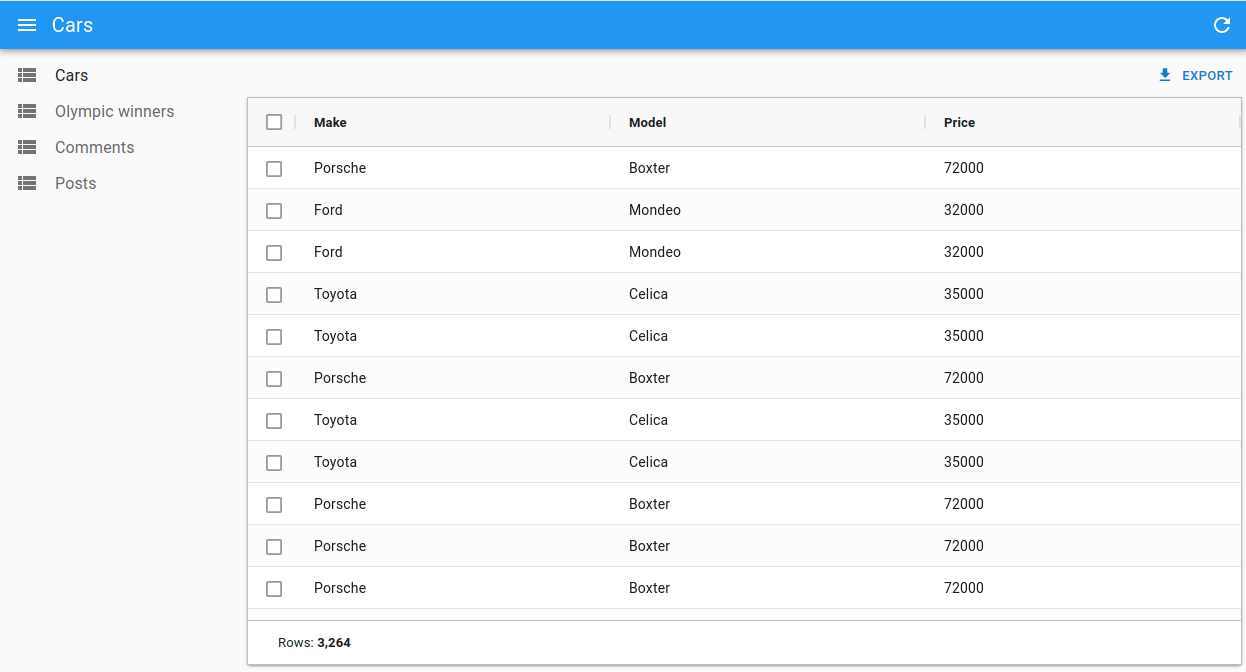
preferenceKey
<DatagridAGClient> will store the gridState in the Store, under the key ${resource}.ag-grid.params.grid. This gridState persisted in the store is applied once when the grid is created, it means that users will find the grid as they left it previously.
If you wish to change the key used to store the columns order and size, you can pass a preferenceKey prop to <DatagridAGClient>.
<List perPage={10000} pagination={false}>
<DatagridAGClient columnDefs={columnDefs} preferenceKey="my-post-list" />
</List>
If, instead, you want to disable the persistence of the columns order and size, you can pass false to the preferenceKey prop:
<List perPage={10000} pagination={false}>
<DatagridAGClient columnDefs={columnDefs} preferenceKey={false} />
</List>
Tip: If you update the columnDefs prop, make sure to clear or invalidate the React-admin store in order to view your changes.
sx
You can also use the sx prop to customize the grid’s style:
import '@ag-grid-community/styles/ag-grid.css';
import '@ag-grid-community/styles/ag-theme-alpine.css';
import React from 'react';
import { List } from 'react-admin';
import { DatagridAGClient } from '@react-admin/ra-datagrid-ag';
export const PostList = () => {
const columnDefs = [
{ field: 'title' },
{ field: 'published_at' },
{ field: 'body' },
];
return (
<List perPage={10000} pagination={false}>
<DatagridAGClient
columnDefs={columnDefs}
sx={{ '& .ag-header-cell-comp-wrapper': { color: 'red' } }}
/>
</List>
);
};

It can also be helpful to change the default grid’s height (calc(100vh - 96px - ${theme.spacing(1)})):
import '@ag-grid-community/styles/ag-grid.css';
import '@ag-grid-community/styles/ag-theme-alpine.css';
import React from 'react';
import { List } from 'react-admin';
import { DatagridAGClient } from '@react-admin/ra-datagrid-ag';
export const PostList = () => {
const columnDefs = [
/* ... */
];
return (
<List perPage={10000} pagination={false}>
<DatagridAGClient
columnDefs={columnDefs}
sx={{ height: 'calc(100vh - 250px)' }}
/>
</List>
);
};

theme
You can use a different theme for the grid by passing a theme prop. You can for instance use one of the themes provided by ag-grid, like ag-theme-balham or ag-theme-alpine-dark:
import '@ag-grid-community/styles/ag-grid.css';
import '@ag-grid-community/styles/ag-theme-balham.css';
import React from 'react';
import { List } from 'react-admin';
import { DatagridAGClient } from '@react-admin/ra-datagrid-ag';
export const PostList = () => {
const columnDefs = [
{ field: 'title' },
{ field: 'published_at' },
{ field: 'body' },
];
return (
<List perPage={10000} pagination={false}>
<DatagridAGClient columnDefs={columnDefs} theme="ag-theme-balham" />
</List>
);
};

Tip: Remember to import the corresponding stylesheet (e.g. ag-theme-balham[.min].css for ag-theme-balham).
AgGrid Defaults
Under the hood, <DatagridAGClient> is a wrapper around <AgGridReact>. However, it sets some important default values:
paginationis set totruepaginationAutoPageSizeis set totrueanimateRowsis set totruerowSelectionis set to'multiple'suppressRowClickSelectionis set totruereadOnlyEditis set totruegetRowIdis set to use the recordidfield
It also register the following default modules: ClientSideRowModelModule, CommunityFeaturesModule and CsvExportModule. If you wish to add custom modules, make sure you have at least the ClientSideRowModelModule:
import '@ag-grid-community/styles/ag-grid.css';
import '@ag-grid-community/styles/ag-theme-alpine.css';
import React from 'react';
import { List } from 'react-admin';
import { DatagridAGClient } from '@react-admin/ra-datagrid-ag';
import { ClientSideRowModelModule } from '@ag-grid-community/client-side-row-model';
import { CsvExportModule } from '@ag-grid-community/csv-export';
import { ClipboardModule } from '@ag-grid-enterprise/clipboard';
const modules = [ClientSideRowModelModule, CsvExportModule, ClipboardModule];
export const PostList = () => {
const columnDefs = [
{
field: 'id',
editable: false,
headerCheckboxSelection: true,
checkboxSelection: true,
minWidth: 48,
maxWidth: 48,
suppressColumnsToolPanel: true,
suppressHeaderFilterButton: true,
},
{ field: 'title' },
{
field: 'published_at',
headerName: 'Publication Date',
},
];
return (
<List perPage={10000} pagination={false}>
<DatagridAGClient columnDefs={columnDefs} modules={modules} />
</List>
);
};
It also includes a defaultColDef object with the following properties:
{
resizable: true,
filter: true,
sortable: true,
editable: true,
headerCheckboxSelectionFilteredOnly: true,
headerCheckboxSelectionCurrentPageOnly: true,
}
You may override any of these defaults by passing the corresponding props to <DatagridAGClient> (defaultColDef will be merged with the defaults).
Accessing The Grid API
You can access the grid’s api by passing a ref to <DatagridAGClient>.
In this example, we use the api to automatically resize all columns to fit their content on first render:
import '@ag-grid-community/styles/ag-grid.css';
import '@ag-grid-community/styles/ag-theme-alpine.css';
import React from 'react';
import { AgGridReact } from 'ag-grid-react';
import { List } from 'react-admin';
import { DatagridAGClient } from '@react-admin/ra-datagrid-ag';
export const PostList = () => {
const columnDefs = [
{ field: 'title' },
{ field: 'published_at' },
{ field: 'body' },
];
const gridRef = React.useRef<AgGridReact>(null);
const onFirstDataRendered = React.useCallback(() => {
gridRef.current.api.autoSizeAllColumns();
}, []);
return (
<List perPage={10000} pagination={false}>
<DatagridAGClient
columnDefs={columnDefs}
ref={gridRef}
onFirstDataRendered={onFirstDataRendered}
/>
</List>
);
};
Check out the Grid API documentations to learn more.
Changing The Default Column Width
By default, ag-grid will render each column with a fixed size.
You can choose to enable flex mode by setting the flex prop either on the columnDefs or on the defaultColDef:
import '@ag-grid-community/styles/ag-grid.css';
import '@ag-grid-community/styles/ag-theme-alpine.css';
import React from 'react';
import { List } from 'react-admin';
import { DatagridAGClient } from '@react-admin/ra-datagrid-ag';
export const PostList = () => {
const columnDefs = [
{ field: 'title' },
{ field: 'published_at', flex: 1 },
{ field: 'body' },
];
const defaultColDef = {
flex: 2,
};
return (
<List perPage={10000} pagination={false}>
<DatagridAGClient columnDefs={columnDefs} defaultColDef={defaultColDef} />
</List>
);
};

Alternatively, you can use the grid’s api to call autoSizeAllColumns to automatically resize all columns to fit their content:
import '@ag-grid-community/styles/ag-grid.css';
import '@ag-grid-community/styles/ag-theme-alpine.css';
import React from 'react';
import { AgGridReact } from 'ag-grid-react';
import { List } from 'react-admin';
import { DatagridAGClient } from '@react-admin/ra-datagrid-ag';
export const PostList = () => {
const columnDefs = [
{ field: 'title' },
{ field: 'published_at' },
{ field: 'body' },
];
const gridRef = React.useRef<AgGridReact>(null);
const onFirstDataRendered = React.useCallback(() => {
gridRef.current.api.autoSizeAllColumns();
}, []);
return (
<List perPage={10000} pagination={false}>
<DatagridAGClient
columnDefs={columnDefs}
ref={gridRef}
onFirstDataRendered={onFirstDataRendered}
/>
</List>
);
};

Check out the Column Sizing documentation for more information and more alternatives.
Selecting Rows And Enabling Bulk Actions
Just like <Datagrid>, <DatagridAGClient> supports row selection and bulk actions.
Add a column with the following definition to enable row selection:
{
headerCheckboxSelection: true,
checkboxSelection: true,
editable: false,
minWidth: 48,
maxWidth: 48,
suppressColumnsToolPanel: true,
suppressHeaderFilterButton: true,
},
Below is an example with the PostList component:
import '@ag-grid-community/styles/ag-grid.css';
import '@ag-grid-community/styles/ag-theme-alpine.css';
import React from 'react';
import { List } from 'react-admin';
import { DatagridAGClient } from '@react-admin/ra-datagrid-ag';
export const PostList = () => {
const columnDefs = [
{
headerCheckboxSelection: true,
checkboxSelection: true,
editable: false,
minWidth: 48,
maxWidth: 48,
suppressColumnsToolPanel: true,
suppressHeaderFilterButton: true,
},
{ field: 'title' },
{ field: 'published_at' },
{ field: 'body' },
];
return (
<List perPage={10000} pagination={false}>
<DatagridAGClient columnDefs={columnDefs} />
</List>
);
};

Just like with <Datagrid>, you can customize the bulk actions by passing a bulkActionButtons prop to <DatagridAGClient>.
import '@ag-grid-community/styles/ag-grid.css';
import '@ag-grid-community/styles/ag-theme-alpine.css';
import React from 'react';
import { List, BulkExportButton, BulkDeleteButton } from 'react-admin';
import { DatagridAGClient } from '@react-admin/ra-datagrid-ag';
const PostBulkActionButtons = () => (
<>
<BulkExportButton />
<BulkDeleteButton />
</>
);
export const PostList = () => {
const columnDefs = [
{
headerCheckboxSelection: true,
checkboxSelection: true,
editable: false,
minWidth: 48,
maxWidth: 48,
suppressColumnsToolPanel: true,
suppressHeaderFilterButton: true,
},
{ field: 'title' },
{ field: 'published_at' },
{ field: 'body' },
];
return (
<List perPage={10000} pagination={false}>
<DatagridAGClient
columnDefs={columnDefs}
bulkActionButtons={<PostBulkActionButtons />}
/>
</List>
);
};
Enabling Infinite Pagination
By default, <DatagridAGClient> renders pagination controls at the bottom of the list. You can disable these controls to switch to an infinite pagination mode, where the grid shows the next rows on scroll. Thanks to ag-grid’s DOM virtualization, this mode causes no performance problem.
To enable infinite pagination, set the pagination prop to false.
import 'ag-grid-community/styles/ag-grid.css';
import 'ag-grid-community/styles/ag-theme-alpine.css';
import React from 'react';
import { List } from 'react-admin';
import { DatagridAGClient } from '@react-admin/ra-datagrid-ag';
const CarList = () => {
const columnDefs = [
{ field: 'make' },
{ field: 'model' },
{ field: 'price' },
];
const defaultColDef = {
flex: 1,
};
return (
<List perPage={10000} pagination={false}>
<DatagridAGClient
columnDefs={columnDefs}
defaultColDef={defaultColDef}
pagination={false}
/>
</List>
);
};
If you have subscribed to the Enterprise version of ag-grid, you can also add a Status Bar to show the total number of rows.

import 'ag-grid-community/styles/ag-grid.css';
import 'ag-grid-community/styles/ag-theme-alpine.css';
import React, { useMemo } from 'react';
import { List } from 'react-admin';
import { DatagridAGClient } from '@react-admin/ra-datagrid-ag';
import 'ag-grid-enterprise';
const CarList = () => {
const statusBar = useMemo(() => {
return {
statusPanels: [
{
statusPanel: 'agTotalAndFilteredRowCountComponent',
align: 'left',
},
],
};
}, []);
const columnDefs = [{ field: 'make' }, { field: 'model' }, { field: 'price' }];
const defaultColDef = { flex: 1 };
return (
<List perPage={10000} pagination={false}>
<DatagridAGClient
columnDefs={columnDefs}
defaultColDef={defaultColDef}
pagination={false}
statusBar={statusBar}
/>
</List>
);
};
Enabling Full Row Edition
By default, editing is enabled on cells, which means you can edit a cell by double-clicking on it, and it will trigger a call to the dataProvider’s update function.

However, if you’d like to update the full row at once instead, you can enable full row editing by passing editType="fullRow" to <DatagridAGClient>:
import '@ag-grid-community/styles/ag-grid.css';
import '@ag-grid-community/styles/ag-theme-alpine.css';
import React from 'react';
import { List } from 'react-admin';
import { DatagridAGClient } from '@react-admin/ra-datagrid-ag';
export const PostList = () => {
const columnDefs = [
/* ... */
];
return (
<List perPage={10000} pagination={false}>
<DatagridAGClient columnDefs={columnDefs} editType="fullRow" />
</List>
);
};

Disabling Cell Edition
Set editable: false in the definition of a column to disable the ability to edit its cells.
import '@ag-grid-community/styles/ag-grid.css';
import '@ag-grid-community/styles/ag-theme-alpine.css';
import React from 'react';
import { List } from 'react-admin';
import { DatagridAGClient } from '@react-admin/ra-datagrid-ag';
export const PostList = () => {
const columnDefs = [
{ field: 'title' },
{ field: 'published_at', editable: false },
{ field: 'body' },
];
return (
<List perPage={10000} pagination={false}>
<DatagridAGClient columnDefs={columnDefs} />
</List>
);
};
Alternatively, you can disable the ability to edit all cells by passing editable: false to the defaultColDef:
import '@ag-grid-community/styles/ag-grid.css';
import '@ag-grid-community/styles/ag-theme-alpine.css';
import React from 'react';
import { List } from 'react-admin';
import { DatagridAGClient } from '@react-admin/ra-datagrid-ag';
export const PostList = () => {
const columnDefs = [
{ field: 'title' },
{ field: 'published_at' },
{ field: 'body' },
];
const defaultColDef = {
editable: false,
};
return (
<List perPage={10000} pagination={false}>
<DatagridAGClient
columnDefs={columnDefs}
defaultColDef={defaultColDef}
/>
</List>
);
};
Using AG Grid Enterprise
<DatagridAGClient> is also compatible with the Enterprise version of ag-grid.
You can follow the instructions in the Getting Started with AG Grid Enterprise section of the Getting Started documentation to enable the Enterprise features.
Below is a short example of what you can achieve.
import '@ag-grid-community/styles/ag-grid.css';
import '@ag-grid-community/styles/ag-theme-alpine.css';
import { AgGridReact } from 'ag-grid-react';
import 'ag-grid-enterprise';
import React from 'react';
import { List } from 'react-admin';
import { DatagridAGClient } from '@react-admin/ra-datagrid-ag';
const OlympicWinnersList = () => {
const columnDefs = [
{
headerCheckboxSelection: true,
checkboxSelection: true,
editable: false,
minWidth: 48,
maxWidth: 48,
suppressColumnsToolPanel: true,
suppressHeaderFilterButton: true,
},
{ field: 'athlete' },
{ field: 'age' },
{ field: 'country' },
{ field: 'year' },
{ field: 'date' },
{ field: 'sport' },
{ field: 'gold' },
{ field: 'silver' },
{ field: 'bronze' },
{ field: 'total' },
];
const gridRef = React.useRef<AgGridReact>(null);
const onFirstDataRendered = React.useCallback(() => {
gridRef.current.api.autoSizeAllColumns();
}, []);
const defaultColDef = {
enableRowGroup: true,
};
return (
<List perPage={10000} pagination={false}>
<DatagridAGClient
columnDefs={columnDefs}
defaultColDef={defaultColDef}
ref={gridRef}
onFirstDataRendered={onFirstDataRendered}
rowGroupPanelShow="always"
groupSelectsChildren
/>
</List>
);
};
Adding An Expandable Panel (Master/Detail)
You can leverage ag-grid Master Detail Module to add an expandable panel.
For instance, here’s how to show the comments of a post in an expandable panel:

import '@ag-grid-community/styles/ag-grid.css';
import '@ag-grid-community/styles/ag-theme-alpine.css';
import { AgGridReact } from 'ag-grid-react';
import { ColDef, CommunityFeaturesModule } from '@ag-grid-community/core';
import { ClientSideRowModelModule } from '@ag-grid-community/client-side-row-model';
import { CsvExportModule } from '@ag-grid-community/csv-export';
import { MasterDetailModule } from '@ag-grid-enterprise/master-detail';
import React from 'react';
import { List, useDataProvider, useNotify } from 'react-admin';
import { DatagridAGClient } from '@react-admin/ra-datagrid-ag';
export const PostList = () => {
const dataProvider = useDataProvider();
const notify = useNotify();
const columnDefs: ColDef<any, any>[] = [
{
headerCheckboxSelection: true,
checkboxSelection: true,
editable: false,
minWidth: 48,
maxWidth: 48,
suppressColumnsToolPanel: true,
suppressHeaderFilterButton: true,
},
{ field: 'title', flex: 1, cellRenderer: 'agGroupCellRenderer' },
{ field: 'published_at' },
];
const detailCellRendererParams = {
// provide the Grid Options to use on the Detail Grid
detailGridOptions: {
columnDefs: [{ field: 'body', flex: 1 }, { field: 'author.name' }],
},
// get the rows for each Detail Grid
getDetailRowData: params => {
dataProvider
.getManyReference('comments', {
target: 'post_id',
id: params.data.id,
pagination: { page: 1, perPage: 100 },
sort: { field: 'created_at', order: 'DESC' },
filter: {},
})
.then(({ data }) => {
params.successCallback(data);
})
.catch(error => {
notify(error.message, { type: 'error' });
params.successCallback([]);
});
},
};
return (
<List resource="posts" pagination={false}>
<DatagridAGClient
masterDetail
columnDefs={columnDefs}
detailCellRendererParams={detailCellRendererParams}
pagination={false}
modules={[
ClientSideRowModelModule,
CommunityFeaturesModule,
CsvExportModule,
MasterDetailModule,
]}
/>
</List>
);
};
